
How do acoustics work?
What is noise?
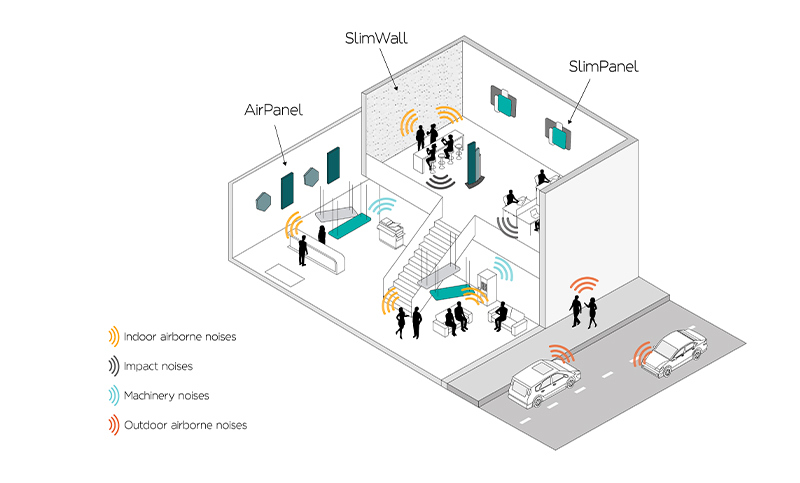
Noises are the combination of several sounds that are heard.
They can be :
• airborne : speech, television, entertainment
• contact : walking, banging, vibrations
• mechanical : ventilation, plumbing, air-conditioning
There are several types of sound. Low-pitched and high-pitched sounds. The frequency comes from the number of vibrations per second: a low-pitched sound arises from few vibrations, a high-pitched sound means there are more. Frequency is measured in Hertz (Hz).
The frequency defines the pitch of a sound.
There 3 types of frequency :
• low frequencies (from 20 to 400 Hz), the most difficult to treat
• mid-range frequencies (from 400 to 1600 Hz), the most audible frequencies
• high frequencies (from 1600 to 20 000 Hz), the easiest to treat
Whan it is emitted, it tends to be modified by variables such as distance or possible obstacles.
• Reduction : in an open space, that is a space in which no obstacles interrupt the propagation of the soundwave its acoustic intensity reduces as one moves away from the sound source.
• Reflection : when a soundwave encounters an obstacle such as the wall of a room, a certain amount of energy is reflected and returns to the room: this is reflection. Successive reflections create a reverberation.
• Absorption : another part of the energy is absorbed by the wall materials, high frequencies are more easily absorbed than low.
• Transmission : part of the energy is carried into a neighbouring room through the walls, that act and a secondary sound source.

The intensity depends on the amplitude of the vibration : the greater it is, the greater the sound ; the weaker it is, the weaker the sound. It is usually expressed in decibels (dB). The duration depends on the time during which the medium is disturbed. The unit used is the second.
What is acoustic comfort?
Sound is everywhere and represents a considerable nuisance in our daily lives. It is measured on a scale of 0 to 130 and its unit is the Decibel. It is known as sound level.
The discomfort that our clients encounter is often linked to an excessive sound level.

What is a decibel ?
The decibel is not a unit like the metre, but a (logarithmic) value of a ratio.
Two sound sources do not create a double sensation, but the second adds to the first. In decibels: 50dB + 50dB does not equal 100dB , but 53 dB.
If two different sound sources are emitted at the same time, it is only the loudest source that will be heard.
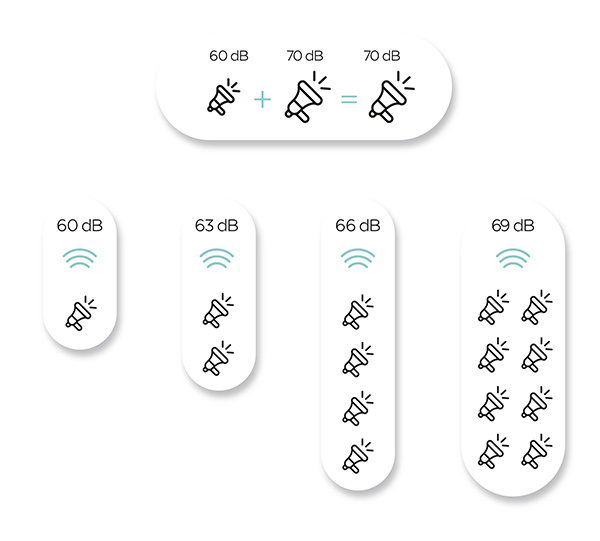
Good acoustics are not necessarily total absorption, but a good distribution of sound waves. To achieve good acoustics, the sound level must be between 40and 60dB.
Above that, it is considered uncomfortable.
Acoustic regulation or standards must therefore be respected in order to deal effectively with the noise and guaranteed the acoustic comfort of a building’s occupants.
Consult the acoustic regulations brochure
Acoustic comfort is therefore the perfect reproduction of a sound (speech, music) to the listeners wherever they are in a room without deterioration (for example echo). A mix of absorbent and reflective surfaces is needed for optimum acoustic comfort.
The difference between insulation and acoustic absorbency :
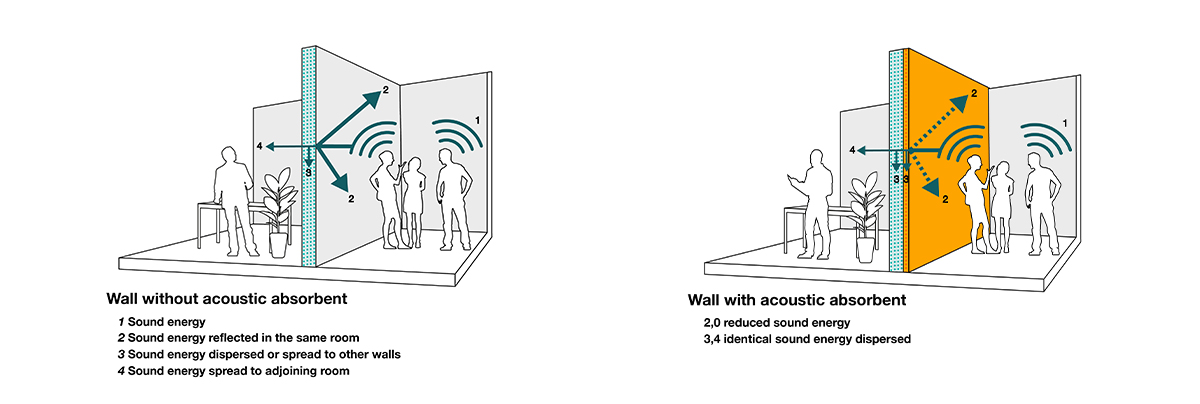
How to insulate ?
Acoustic insulation limits or controls the transmission of noise between different rooms :

For optimal insulation, sound bridges must be kept to a minimum. These are unclosed spaces that allow soundwaves to penetrate into the neighbouring area (under doors, in metal frameworks, partitions on a shared floor)
.
It is also necessary to add mass to the wall. A thick but porous product will not stop the propagation of the wave. However, the heavier and denser the material, the more they limit the spread of the sound energy.
How to deal with sound absorption or correction?
The acoustic correction of a room implies a carefully examined architectural design at the start of the project.
As well as the use of absorbent materials to control the sound energy reflected on the walls.
The reverberation is greater the larger the room and the smoother and harder the walls (glass, tiles, concrete…) To reduce the sound reverberation of a room, the frequencies that make up the noise must be reduced by using absorbent materials. The acoustic absorption is ensured by thick and porous components: fleece or foam backing for acoustic wallcoverings, non-woven sheets or compact felt for acoustic panels.
What are the benefits of acoustic correction?
The 2 main problems linked with noise reverberation
• The increase in sound level: when several individual speak simultaneously, reverberation amplifies the sound level (restaurants, meeting rooms, banqueting halls, communal areas of hotels or offices…)
• Poorer understanding or appreciation of the sound source : poor clarity or unintelligible voices (conference rooms, school buildings, music rooms or cinemas)
The main areas affected by noise
All public areas experience sound reverberation problems at different levels :
• communal areas : corridors, entrance halls, stairwells
• meeting, seminary or conference rooms
• school refectories, company restaurants
• concert halls, banqueting suites or multi-purpose rooms
• music halls or cinemas
• in private homes in rooms in which acoustic quality is needed : home cinemas, music rooms, children’s playrooms, reception rooms
The aim : bring a specific acoustic advantage to each area
• Improve the clarity of a sound : music rooms
• Improve the intelligibility of a voice : classrooms, conference rooms
• Improve concentrations : office or open plan workspaces
• Create a private space : meeting room, entrance areas, hotel lobbies
• Improve communication : restaurants, shared spaces
• Manage the sound level to reduce propagation : communal corridors, rest areas
Consult the “Le Confort Acoustique” (acoustic comfort) brochure
How to measure the sound quality of a room ?
Reverberation time Tr
The sound quality of a room is measure by the reverberation time (Tr) which is defined as being the time needed for the sound to decrease by 60dB after the sound source has stopped. In a room the sound bounces of the surfaces such as the floor, walls, ceiling, windows or tables several times. The higher the acoustic absorption, the shorter the reverberation time.
The reverberation time in a room can be calculated thanks to the Sabine formula, an accurate formula so long as the distribution of the absorbent is homogenous :
Tr = 0.16 V / A
V = the volume of the space (the higher the volume, the greater the Tr)
A = equivalent absorption area (AAE)
Units of reference for acoustic absorbency :
AEE : used for panels or acoustic objects. Alpha w is used for complete surfaces such as wallcoverings.
The absorption capacity depends on its absorption coefficient (alpha) but also its surface (S). We call the equivalent absorption areas quantity A = alpha x S
αw : used for complete surfaces such as wallcoverings
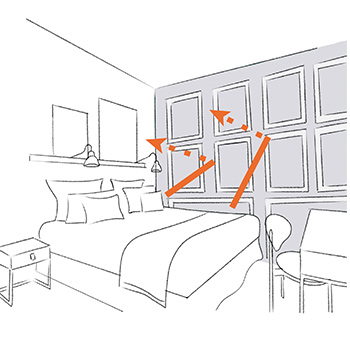
Wallcoverings : the waves only hit the surface of the product.
Example : 5m² of Vinacoustic wallcovering alpha w = 0.25 => AEE = S x alpha w = 5× 0.25= 1.25m²
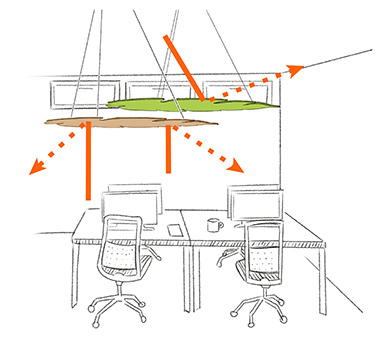
Acoustic objects or panels: the waves hit all the surfaces of the product.
Example: if 2 sheets are installed, for which the Aeq per unit = 0.85m² => AEE = 0.85×2 =1.70m²
Texdecor acoustic comfort solutions
The Texdecor range consists of 6 complementary product groups, to be used independently or combined, depending on the acoustic advantages required, the decor and the architecture of the space to be treated :
Vinyl acoustic wallcoverings
Textile acoustic wallcoverings
Compact-felt acoustic wall panels
Textile-covered acoustic panels
Compact-felt acoustic panels
Acoustic objects



